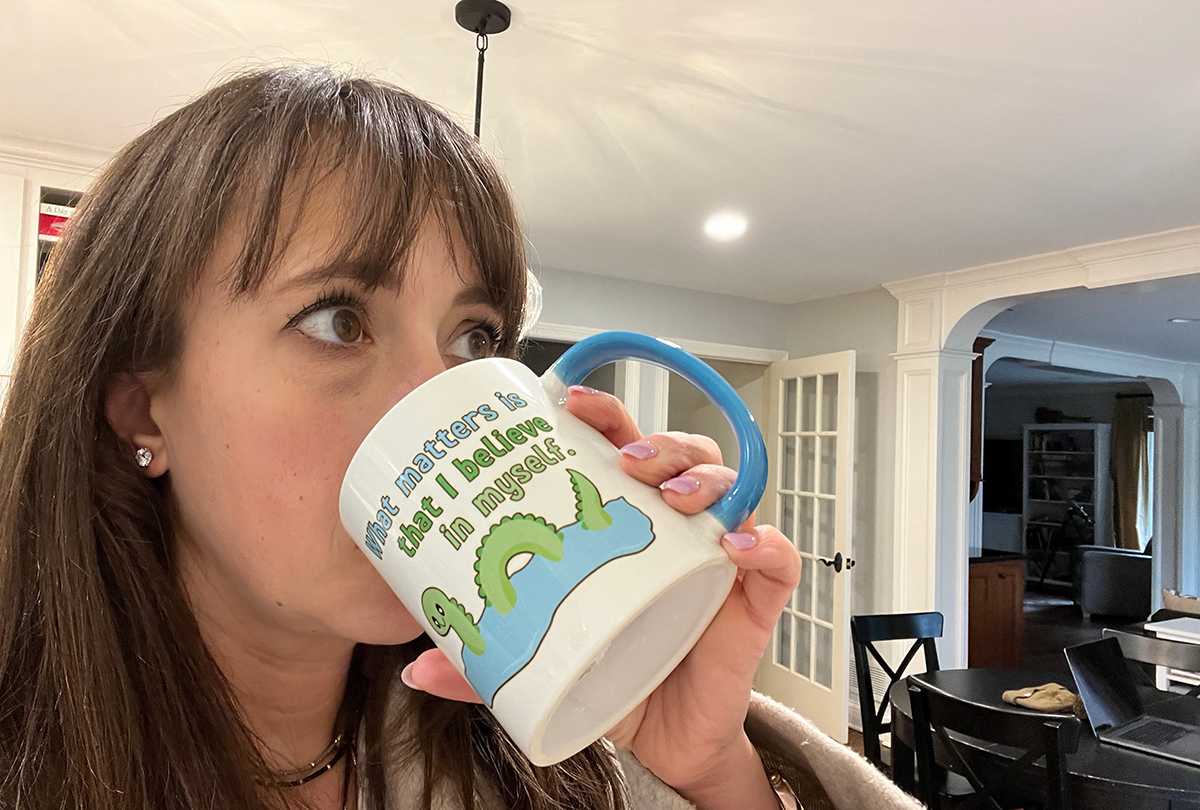With Nessie, It’s Always Been Hit and Myth
By Rebecca Siegel
It was nearly midnight in the little village on the north shore of Loch Ness, but the sun still hung stubbornly in the sky. The loch’s placid surface was a blue-grey mirror. Seagulls cawed noisily overhead, interrupting the otherwise silent night. I checked into my tiny roadside cottage, decorated in kitschy Loch Ness Monster décor, and collapsed on the single mattress, feeling more like I’d arrived at a sleepaway summer camp than on a research expedition. I mentally reviewed the coming days: interview, interview, interview, archive, tour, monster hunt. I stared at the ceiling and wondered what I’d gotten myself into.
I had come to Loch Ness on a mission, not to find the monster, but to explore the story behind the myth for a new middle grade nonfiction book. I was fascinated with the Surgeon’s Photo, that famous black and white image purporting to show a monster’s head and neck rising above the rippling waters of Loch Ness. Of course, we now know that the Surgeon’s Photo was a hoax. But it was the story behind the photo that had captivated me. Perpetrated by a dynamic group of brilliant, upper crust pranksters, the Surgeon’s Photo was the product of two film dynamos, one special effects artist, and one doctor who would later become a pioneering spy with the British Special Operations. These were tweeded gentlemen who spent their weeks among London’s fashionable circles and their weekends hoodwinking the whole world. It was Ocean’s 11 meets Downton Abbey, with a splash of Jurassic Park thrown in for good measure. I couldn’t get enough.
(The précis: In 1934, a mustachioed man-about-town with the incredible name of Marmaduke Wetherell staged a phony monster photo in order to get a little good-natured revenge on London’s Daily Mail, a publication for which he’d embarked on a blunder-filled Nessie hunt. The Daily Mail believed that the image was real, ran it, and thus raised the temperatures on an already raging global case of monster fever.)
Before I drifted off for a couple hours of precious, jet-lagged sleep that night, my last thoughts circled around how I’d handle the dynamics of the coming days. As a nonbeliever, would I offend the good people of the Loch Ness Exhibition Center? What about the folks running Loch Ness Cruises? Nessieland? How would they respond to my questions about the photo and the men behind it? I didn’t think Loch Ness ever froze, but I might find myself on thin ice nonetheless.
Loch Ness/Photo by Rebecca Siegel
I was in for two big surprises. The first was that I was dead wrong about offending locals with my questions about the Surgeon’s Photo prank. The monster hunters and monster experts I interviewed were kind, funny, and incredibly self-aware. They knew every detail of the prank, and also saw the Nessie legend for exactly what it was: a great story, something that inspired curiosity and exploration, and an economic boost as well. Nobody tried to pass off fabricated evidence as legitimate, or falsehoods as facts. I felt relieved that I wouldn’t have to do this dance with anyone. I was too jet lagged to feign belief. The second surprise was that the people I’d most offend with this story were on the other side of the Atlantic: Americans.
Once stateside again, I found myself in an unending stream of conversational nonstarters.
“What’s the new book about?” some well-meaning friend would ask.
“The true story behind the Loch Ness Monster myth,” I’d answer carefully, hopefully.
“Oh,” would come the inevitable response. “I love Nessie!”
My shoulders would droop, and I’d nod apologetically before launching into my spiel:
Nessie isn’t real, but the story behind her myth is fantastic. Dramatic. An incredible, once-in-a-lifetime intersection of Hollywood, science, political turmoil, financial crisis, and an unchecked news media. Nessie had been around for a year before the Surgeon’s Photo, of course. But only just, and she wasn’t the phenomenon she’d grow to become. Rather, before the silly little prank-turned-global sensation launched the Loch Ness Monster into the stratosphere, she was just a goofy little story told by a hotel manager trying her best to make a buck. Nessie’s rise to fame required this exact set of circumstances. It’s almost unbelievable!
Seeing the repeated looks of polite disappointment did something to me. I wasn’t sure if this book would really work. Would anyone want to read about how their favorite monster wasn’t real? I sat at my desk and rolled a pen between my fingers.
There were really two monsters in the story. (Well, three if you count Hitler, who figures into the Nessie story as well, but my agent said I needed to focus.) One monster was obviously Nessie. But the second monster was just as important to the tale: Fake News. The Loch Ness Monster’s fame was the product of 1930s media misinformation, of a whole generation of unapologetic journalists in a hand-to-hand battle for readership. These were editors, publishers, and boots-on-the-ground reporters who’d do anything for an inch of newsprint. They fudged facts. Speculated. Got downright creative. The result of their work was an impressive echo chamber of bogus monster chatter. Readers wanted monster stories. Papers printed them. Readers believed monster sightings. Papers reinforced this belief. Looking back at the Loch Ness Monster’s rise to fame is a great, simple case study in Fake News.
This book would work.
Teachers need to teach young readers about Fake News. Teachers need to teach young readers to develop media literacy—the skills necessary to navigate information in the complex, nuanced, digital world. And yet, some teachers aren’t sure how to do it without incurring the knee-jerk anger of a community uniquely primed to push back against anything remotely resembling politics. How can anyone talk about Fake News without mentioning Donald Trump? Well, I’ll tell you. They can teach their learners about the true story behind the Loch Ness Monster myth.
My fingers flew across the keyboard.
In truth, I still spend plenty of nights wondering what I’ve gotten myself into. Life as a children’s book author can be tough. If I’m not stressing about sales or deals, I’m fretting about reviews. Reactions. Many of my books touch upon topics now considered politically charged, such as gender discrimination, racial bias, and now, Fake News. I worry that I’ll find myself on the business end of some far-right conspiracy theorist’s Truth Social tirade. They’ll see the title of a book and assume I’m out to indoctrinate children. This, in turn, will ricochet throughout the internet, generating likes, reposts, and responses from others who read headlines but not articles (let alone the books themselves.) People will spread rumors and lies.
I suppose if that does happen, I’ll take comfort in knowing that I’ll have a little something in common with the Loch Ness Monster.
***
Rebecca Siegel has worked in children’s publishing for 17 years, first as an editor and then as an author. Three of her books have received Starred Reviews in Booklist, including To Fly Among the Stars (Scholastic 2020), which was also named a Mighty Girl’s Book of the Year, and one of the National Science Teaching Association’s Outstanding Science Trade Books for Students. Another recent title, Mayflower (Quarto 2020), was called “unreservedly recommended” by the Midwest Book Review, and was named a 2021 EUREKA! Children’s Honor Book. Rebecca has three books publishing in 2024: LOCH NESS UNCOVERED (Astra Young Readers), WRECKED! (Welbeck), and THE UNITED STATES BOOK (Welbeck). In addition to books, Rebecca also occasionally publishes essays on sites like Huffington Post and Scary Mommy. She lives in the Chicago suburbs with her husband and two daughters. When she’s not writing, she likes to make pizzas and listen to spooky podcasts. You can find out more about Rebecca and her books—including Loch Ness Uncovered—on her author website, https://www.rebeccasiegel.org/.
The author in Scotland with Adrian Shine, the world’s foremost expert on the Loch Ness Monster
***
“If they want a monster so badly, they ought to be provided with one.” –Margaret Atwood, Alias Grace


